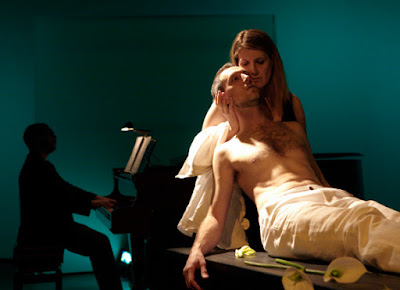Contradiction equals balance.
That was the phrase I kept returning to at the end of Death & Desire, the latest production from Toronto’s Against The Grain Theatre. The group, known for their innovative approach to opera and stagings, were lauded last winter when they staged an unconventional version of Mozart’s Don Giovanni, called #UncleJohn, first at the Banff Centre, then in Toronto, at the Great Hall. Turning the opera’s libretto upside-down, the audience became part and parcel of the action, implicated in the main character’s nefarious deeds but nevertheless seduced by his charm.
With Death & Desire, they had no libretto to work from, but rather, two vastly different song cycles, Schubert’s Die schöne Müllerin, and Messaien’s Harawi, each of which alternate throughout the work. The former, sung from the point of view of a lovelorn man, and the second, from a woman, sharply contrast in both style and content. Yet Director Joel Ivany and Music Director Topher Mokrzewski find the threads of connection that lay bare the bold, bald, frequently painful beauty within. Set within the intimate space of the Neubacher Shor Contemporary gallery, in the west end of Toronto, a world where clashes and conflict equal grace and harmony is laid out, asking us to consider contrast as a means for deeper exploration of both theatrical possibilities as well as emotional ones. It’s as if Ivany and Mokrzewski want to jar us on-purpose, swinging from Schubert’s sing-song melodies to Messaien’s jagged tunes, in order to keep hammering home the balance that is, inevitably, happening before our very eyes and ears.
 |
| Photo by Darryl Block |
As realized by baritone Stephen Hegedus and Krisztina Szabo, Death & Desire takes on range of hues that far exceeds those outlined by the intentions of its original composers. Schubert’s melodies are given a range of deeply felt experiences that move beyond mere Werther-like sulkiness by the work’s end, while Messaien’s work becomes less a surreal collection of abstractions than a dogged look at the underbelly of that experience, a shadow-self to the Schubert that is needed in order to provide the sour flavor that turns to a smooth, tasty libation by the piece’s end. When Szabo rips away bunches of calla lilies, we’re horrified by the destruction, even as we note the bizarrely beautiful pattern the white petals create on the shiny black floor. When she sings, at one point in the text, in Quencha, we note the rhythmic nature of the words that slap up against the melodious smoothness of the Schubert he’s just sung. Hegedus and Szabo are less “man” and “woman,” respectively, than they are representative of different worldviews, contrasting ideas being played out (or rather, sung out) live within an intimate cozy, sometimes suffocating, sometimes deep, dark space. Death & Desire is less about romance than it is about trying to communicate past the ego notions we’re expected to identify with; thus does the “desire” bit keep falling away to reveal death, and, simultaneously, a deep kind of love that transcends the physical. “L’Amour, la mort” indeed.
 |
| Photo by Darryl Block |
Frustrating at times to listen to, Harawi works in this setting precisely because of the intimacy afforded it —via the venue, the careful direction, the loving performance by Szabo, and the stellar chemistry between she and Hegedus, who, himself, brings a heartbreakingly beautiful energy. He might be an idea, but he’s one you want to embrace, one you can’t help but recognize and feel for, and his strong, gorgeous baritone is perfectly modulated to encompass a range of emotions. Szabo’s steely soprano beautifully captures the chaos of the work, as well as its stillness — no small feat. Each performer has such a different feel and sound for the work, but one never overpowers or over-compensates; rather, it’s a lovely give-and-take energy that is highly supported by Mokrzewski’s fantastic piano playing, and utterly complemented by Jason Hand’s keen use of lighting. At one point, Hegedus is bathed in a sickly tomato-red light, at other, tender moments, he and Szabo walk around the perimeter of the performance area with a rich indigo-backdrop and gentle, warm lighting; less a case of obvious indication, the lighting, like Michael Gianfrancesco’s elegantly spartan set, serves to highlight the varying viewpoints, ideas, and experiences at play between the characters, to sharpen, and then soften differences — ones that eventually melt away by the end of the work. At no point does Ivany dictate to his audience how we should feel (there’s a nice feeling he trusts us enough to avoid the spoonfeeding), a quality in short supply within the opera/theatre worlds, to be sure. I’ll be curious to see how he much of that he carries over to his directorial debut of Bizet’s Carmen for the Canadian Opera Company next season.
 |
| Photo by Darryl Block |
In the meantime, Death & Desire is a work for our times — and all times — asking us to consider how much we can stand our views being challenged, and how much peace we can make with that reality. Can we move gracefully to a place of love and acceptance? Maybe. It’ll take a bit of work, though — and more than a few broken petals along the way. That’s a good thing. There’s beauty in destruction, and balance in contradiction, too. Finding it is painful, but so very rewarding.
